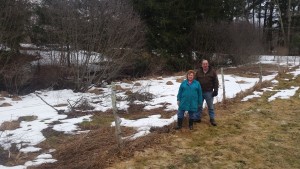
A small commitment from the Irelands protects a Connecticut trout stream that flows into the Natchaug River. The Irelands use USDA conservation programs to improve water quality and prevent erosion on the stream bank.
Windham County farmers, William III and Sally Ireland, know they are fortunate to live so close to one of the state’s top trout streams that runs nearly 18 miles through northeastern Connecticut.
The Natchaug River is a trophy trout stream, which means that it is stocked annually with a higher proportion of larger fish.
“We enjoy camping along the banks while our grandchildren fish,” said William. “We also like watching fly fishermen cast their lines in pursuit of the elusive trout in the Natchaug River.”
The river eventually runs into Mansfield Hollow Lake, a 500-acre lake for boating and fishing that is also used as a public water supply.
The Irelands know it is important to do their part to ensure the water and streams on their farm, which feed directly into the river, remain as clean as possible.
When William and Sally became concerned that their growing cow herd could be causing damage to stream banks and affecting the water quality, they turned to USDA’s Farm Service Agency (FSA) and Natural Resources Conservation Service (NRCS).
In 2001, after weighing their options, they enrolled 1.4 acres of their family farm into the Conservation Reserve Program (CRP) to help keep the streams clean and prevent the streambanks from eroding.
CRP is among the largest private lands program for conservation used to reduce soil erosion, improve water and air quality and provide wildlife habitat.
USDA staff worked with the Irelands to develop a plan that included fencing along the stream, forested riparian buffers and controlling invasive plants. Stream crossings were also built to allow grass to grow to protect the streambanks from erosion and to improve water quality. The Irelands also created an alternate source of water for the animals.
As the Ireland’s initial 10-year CRP contract neared expiration in 2011, it was an easy decision to renew for another 10 years through 2021.
“Because of CRP we are doing a good job protecting the stream and we want to continue doing what we can to help the environment,” said William. “Participating in the program helped us realize that even though we only enrolled 1.4 acres, these acres are an important contribution to improved water quality for our farm and the people who rely on water from the Mansfield Reservoir downstream.”
CRP is a voluntary program that allows eligible landowners to receive annual rental payments and cost-share assistance to establish long-term, resource-conserving covers on eligible farmland throughout the duration of their 10 to 15 year contracts.
Under the program, farmers and ranchers plant grasses and trees in fields and along streams or rivers. The plantings prevent soil and nutrients from washing into waterways, reduce soil erosion that may otherwise contribute to poor air and water quality, and provide valuable habitat for wildlife.
Since being established on December 23, 1985, CRP has helped prevent more than 8 billion tons of soil from eroding and protected more than 170,000 stream miles with riparian and grass buffers, more than 100,000 acres of bottomland hardwood trees, nearly 300,000 acres of flood-plain wetlands, and 250,000 acres each for duck nesting habitat and upland bird habitat.
2015 marks the 30th Anniversary of CRP. For an interactive tour of CRP success stories from across the U.S., please visit the FSA CRP 30th Anniversary website at http://www.fsa.usda.gov/CRPis30 .
To find your local USDA Service Center please visit http://offices.usda.gov.





